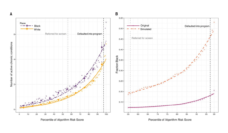A father of a high school teen walks into Target with a coupon in hand. He’s furious. His daughter is just a kid, yet Target sent her a coupon discounting everything she would need for a healthy pregnancy. Are they promoting underage sex? The manager knows nothing about the coupon but apologizes anyway. The father returns home, still agitated by the audacity of these people. His daughter finally confesses. The baby is due in August.
Your patterns of technology use, also known as a digital footprint, say a lot about your health. Data scientists create algorithms to predict wants and needs of on-line consumers by at looking purchases, social media posts, and internet searches. Target accurately predicted the teen’s pregnancy status by comparing her shopping behaviors to purchasing patterns of other women who have used the company’s baby registry.
David Grande and his team interviewed 26 health technology experts to uncover challenges to maintaining privacy in the age of digital information. They asked open ended questions to get a broad picture of the way different sources of information can be aggregated to track private information. The experts explained that formal health records stored in hospital databases receive extensive protections under federally enforced HIPAA policy, but few regulations protect other personal data like online reviews, call logs, or frequent flyer accounts. Thus, the experts noted that all data is health data when aggregated across platforms.
The figure above highlights the many ways data scientists collect health information and provides several quotes explaining how this information can be used. Some methods rely on simple inference. If you search on Google where to purchase a blood pressure monitor, a data scientist can logically assume that you (the anonymous consumer) do not already own one. Other data scientists can use methods that rely on even more complex information syntheses, like comparing the content and frequency of phone calls and emails to uncover sudden or progressive changes in health.
Grande and his team call on US policymakers to redefine health privacy and generate new safeguards to protect against further health privacy violations. Until then, and whether we want it or not, Target or anyone else with something to sell can continue to employ data scientists to aggregate personal health information that direct us toward what they think we need to buy.
Databyte via Grande, D., Luna Marti, X., Feuerstein-Simon, R., Merchant, R. M., Asch, D. A., Lewson, A., & Cannuscio, C. C. (2020). Health Policy and Privacy Challenges Associated With Digital Technology. JAMA network open, 3(7), e208285.














